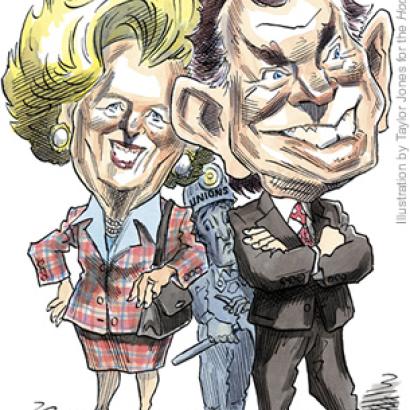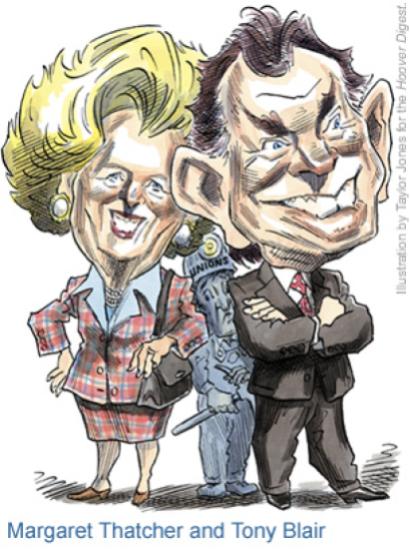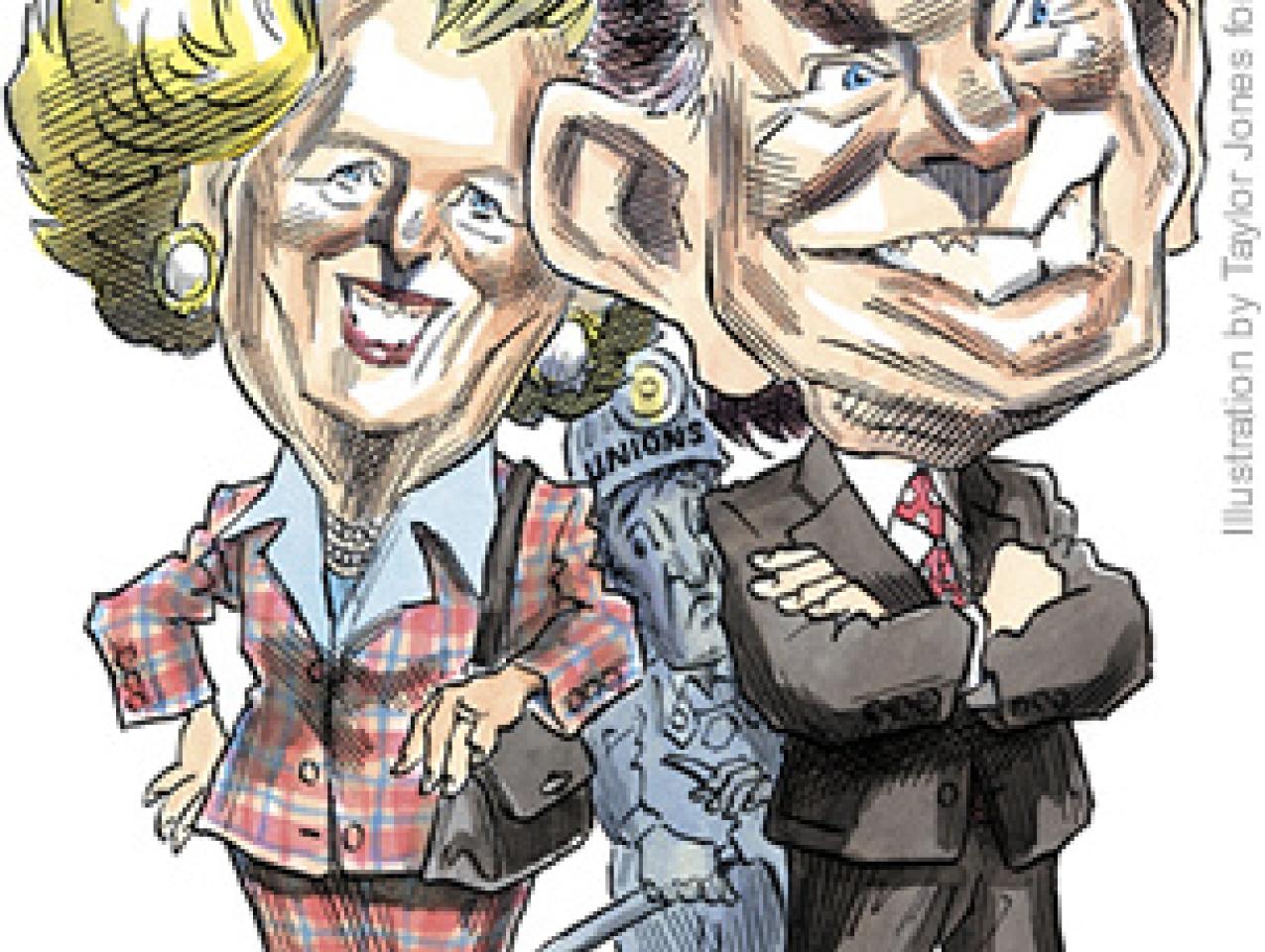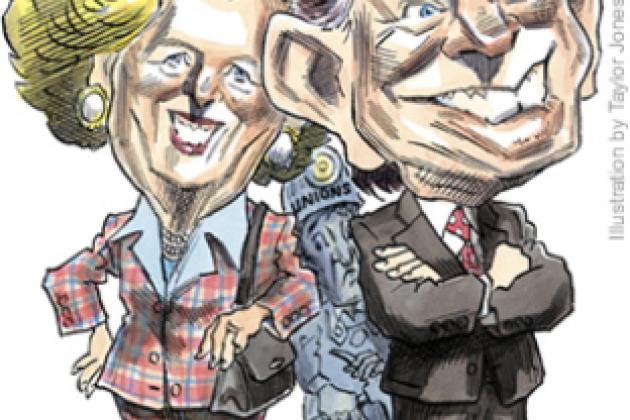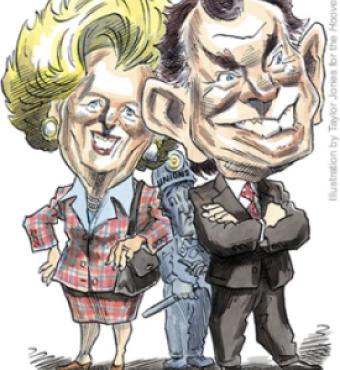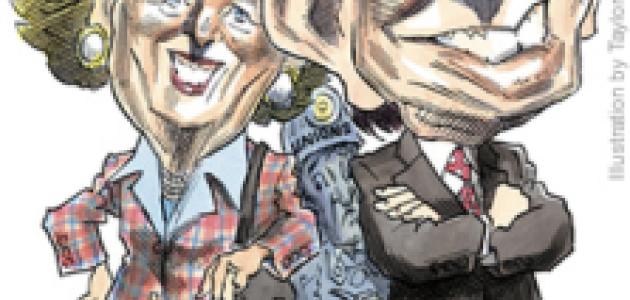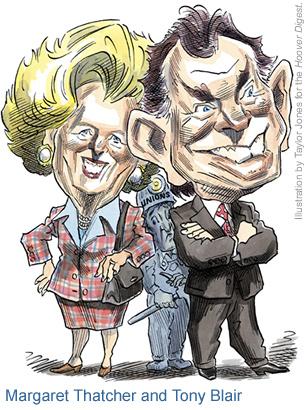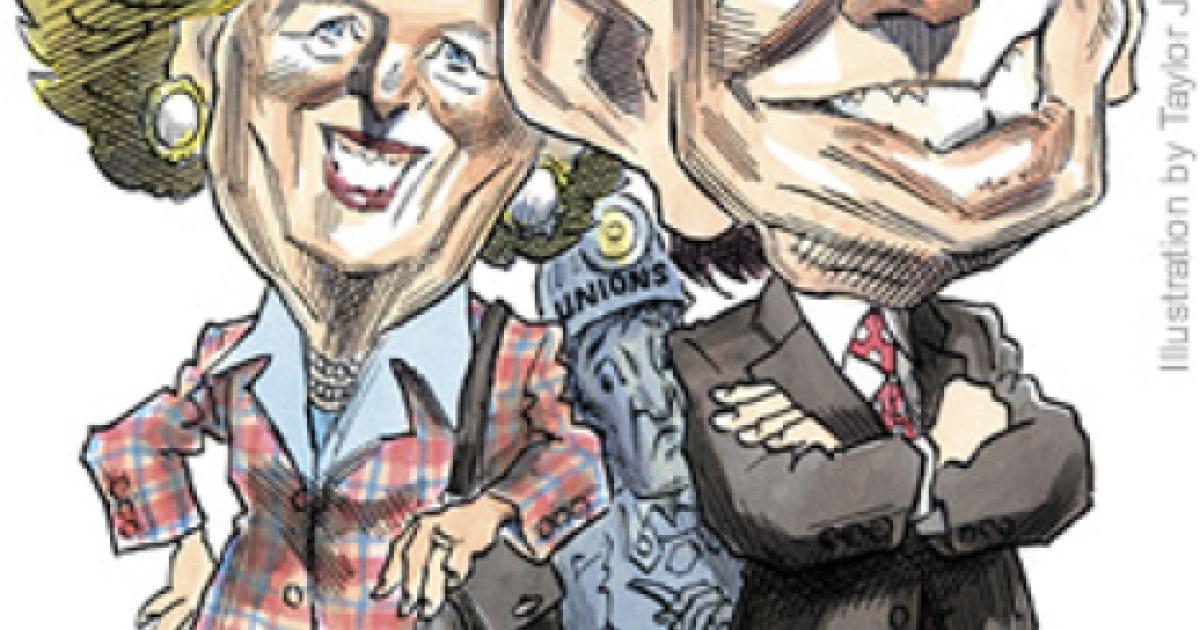- US Labor Market
- Contemporary
- International Affairs
- Economics
- History
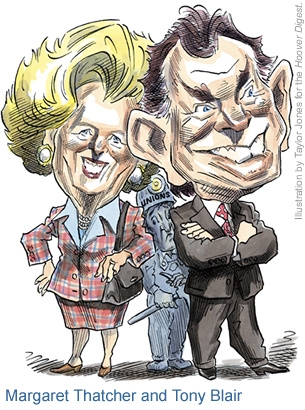
The power of British unions to influence the policies of British governments has dramatically waxed and then waned over the 60 years since the Second World War ended in 1945. For the first 35 years after the war, British unions operated at the very center of British government, negotiating with Conservative as well as Labour governments about the details and implementation of economic, social, and employment policy. Then, for the following quarter century, starting in 1979 when Margaret Thatcher and her Conservative Party came to power, unions were driven from the British policy process, laws were passed to restrict unions’ right to strike, and at the same time unions suffered a disastrous halving of their national membership, from 12 million to not many more than 6 million members. Put another way, unions went from representing more than 60 percent of Britain’s workforce in 1979 to less than a third today.
Finally in 1997—after 18 unbroken years in power—the Conservative Party was swept from office by a Labour electoral landslide led by Tony Blair, who became prime minister; and with Labour’s return to office came union leaders’ hopes that “their” government would restore a significant measure of their influence and participation. Those union leaders did, however, understand that the political landscape in Britain had changed in 1997 and that, although they hoped for restored influence, their role would need to be more restrained and above all less public because memories of the disastrous strikes of 1978–79 that had brought down the last Labour government were still fresh. But they were not prepared for what happened. Eight years and three terms into Blair’s Labour government, British unions are bitterly disillusioned that their influence is so modest and sub rosa. In fact, many unionists go so far as to say that they cannot think of a reason why they should continue to support Labour. They remember bitterly that the union movement founded the Labour Party as its political wing in 1900 and that even today British unions continue to support the Labour Party, being its largest financial contributor.
What then happened to produce such enormous union power after the Second World War? What happened to reverse that power under Mrs. Thatcher’s Conservative government? Why has the union movement remained so weak even though “its” Labour government has now been in power for nearly eight years? Finally, and most important, what is likely to happen to the union–Labour government relationship in Labour’s third term?
How Did Unions Become So Powerful after World War II?
Union power in Britain emerged as a consequence of the work of the Labour government headed by Prime Minister Clement Attlee from 1945 to 1951. The Attlee government radically transformed Britain’s economy and social welfare system, creating a managed economy and welfare state that committed the government to ensuring that Britain’s severe interwar depression could not return. Its purpose was to see that postwar Britain enjoyed a high and rising standard of living, including “guaranteed” full employment. This idea was agreed on jointly by the Labour Party and the union movement during their years in the political wilderness during the depression of the 1930s and the war years. Roosevelt’s New Deal in the United States and the thinking of the economist John Maynard Keynes were at its intellectual core.
The Conservative Party led by Winston Churchill sharply opposed what it described as this “socialization” during the 1945 election. But, after being overwhelmingly defeated in that election by British voters who strongly feared another depression, the Conservatives, still under Churchill’s leadership, quickly and very strategically changed their position. Believing that Britain had experienced a political earthquake that had changed the landscape, the Conservatives by 1947 had rethought their position and, astonishingly, accepted Labour’s radical program: that the British government would now accept responsibility for protecting the well-being of every British citizen from the “cradle to the grave.”
Thus, by the time the Conservatives returned to power in the 1951 election, they had embraced Labour’s radical changes, which brought not only a commitment by government to manage the economy and operate a welfare state but a new relationship with the British union movement. Unions became empowered because of their considerable leverage over the likely success of the managed economy. The government’s maintenance of a full employment policy, in particular, meant that unions had to restrain wage demands so that Britain could sell enough internationally to finance the new economy. Thus, the era of British collectivist politics between unions and government was born, giving rise to great hopes that this partnership would allow government to create and maintain a prosperous society.
But these great hopes were not to be realized. During the 35 years that followed, from 1945 until 1979, the relationship between the unions and governments failed to work as had been hoped for. British governments of both major parties lurched from one economic and financial crisis to another. Britain’s economy, already in a long decline before the Second World War, had trouble competing in world markets following the war, particularly when the union movement failed to deliver the wage restraints it had agreed on with the Attlee government. Although there were short periods of effective wage restraints, over the years full employment turned out to be an irresistible power in union hands. Union leaders initially wielded enough power to keep wage increases in check, but gradually and repeatedly their authority failed as shop floor workers demanded that their leadership press for the most lucrative wage deals they could. And when shop floor workers became dissatisfied, they staged increasing numbers of “unofficial” or wildcat strikes. The problem was that the unions were asked to be restrained in using the bargaining leverage that full employment provided to demand and win ever higher wages. But their leaders found it increasingly difficult and then impossible to keep their membership in check. Wildcat strikes became epidemic. Rancorous labor relations brought the British economy to periodic standstills. By the end of the 1970s, with a Labour government in power, the whole relationship essentially collapsed as the unions staged massive strikes during the winter of 1978–79, which came to be known aptly as the Winter of Discontent. The strikes gave the Conservatives a great political weapon, for the unions soon became “public enemy number one.”
The Thatcher Revolution
The elections of May 1979 proved a political watershed. The Labour government, headed by Prime Minister James Callaghan who ironically had been a favorite of the union movement, was turned out, largely for its failure to control union militancy. In his place came Margaret Thatcher who, though elected primarily because of the Labour government’s helplessness, was nevertheless armed with a radical commitment to stop union power, to push unions out of their negotiating position inside Number 10 Downing Street, and to marginalize union power in all its manifestations, including the power to wage wildcat strikes. Mrs. Thatcher and her colleagues proved to be as diligent and effective in their attack on union power as the Attlee government had been in establishing union power 34 years earlier. Most pundits at the time strongly doubted that Mrs. Thatcher could succeed in attacking the unions because her predecessors, both Labour and Conservative, had failed so miserably to do so. In fact, the previous Conservative government, led by Edward Heath, had been voted out of office after failing to legislate restraints on union strike power and then falling victim to an all-out coal miners’ strike in 1973–74. But Mrs. Thatcher proved them wrong. By the end of her first two terms in office (eight years), and against all dire predictions, Mrs. Thatcher had turned the old Conservative fear of union power into a confidence that Conservatives could successfully confront and restrain union power, in stark contrast to the impression that the Labour Party was at the mercy of union power. Moreover, Mrs. Thatcher not only succeeded in confronting union power head-on but greatly increased her own political stature, to the point that she became known as the “Iron Lady” and her policies as “Thatcherism.”
Of course the Thatcher “revolution” was far more than just an effort to destroy union power; it was a highly significant restructuring of economic decision making emphasizing market forces, selling off nationalized industries, and deregulating large segments of the economy. In effect, her government ended the era begun by the Labour Attlee government and with it removed government’s dependence on its collectivist relationship with the unions. As a consequence, banishing the union leadership from policy negotiations with the prime minister at Number 10 Downing Street was accomplished without much more than a whimper from the unions and with loud applause from the electorate. Management of the economy moved away from government as the privatization of many government industries proceeded rapidly, along with the end of severe regulation of transportation, communication, and financial activity. By the time she herself was sent packing from Number 10 by her own Conservative colleagues in late 1990, it could be said with confidence that Mrs. Thatcher had indeed ended one era of British political life and opened another.
Labour’s Relationship with the Unions: Complicated and Troubled
The union–Labour Party relationship has been best portrayed by the joke about the couple who are interviewed on the occasion of their 50th wedding anniversary. When asked whether they have ever argued, they reply, “Of course, all the time.” When they are next asked whether they have ever contemplated divorce, they reply firmly “No!—but murder, yes!”
From Labour’s founding by the unions as their political arm, British unions have looked at the party as “ family.” Unions have always worked for, and passionately hoped for, a Labour Party victory at every election. In return for this effort and their financial contributions, unions expect that Labour governments will support and promote union interests, whether by legislation or policy actions. The actual relationship has failed to meet union expectations—as well as expectations from the Labour government side. Although the Attlee government almost totally delivered on its promises to build a managed economy and social welfare state, and from their side unions largely reciprocated with broad-based cooperation, the record since then has been one of constant frustration on both sides. In fact, unions have more often than not felt that Labour governments have consistently demanded more than they were willing to deliver in return. In fact, before Mrs. Thatcher appeared on the scene, the unions often found that so-called hated Conservative governments were easier to live with because they were afraid of union power and, lacking influence with unions, asked less of the union movement than Labour governments. In fact, Conservative governments before Mrs. Thatcher’s often gave in to union power.
Of course Mrs. Thatcher turned Conservative fears into political power against the unions. She rewrote the relationship between unions and government and, in so doing, actually provided advantages for Tony Blair when he led Labour back into power in 1997. Unions understood from the beginning of the Blair government that they needed to keep a low profile and not be seen as too influential. To be highly visible would be politically dangerous, given memories of the Winter of Discontent. Also, the unions understood that the Blair government would not remove the legislative restraints on strike action that the Conservatives had enacted, for to do so would have been the “kiss of death” as far as the electorate was concerned. In short, when Tony Blair took office as prime minister he enjoyed the advantage of the union movement’s accepting that “its” new Labour government would not be restoring it to the position of power and influence that it had enjoyed 25 years earlier. Yes, Labour would be a “friendly” and sympathetic government that would not continue the Conservative pattern of relentlessly pressing forward with new restraints on union power; and yes, “their” Labour government did promise to enact a minimum wage for the first time, but from the larger perspective unions could not expect the “good old days” to return anytime soon.
What has actually happened to the union movement under eight years of a Labour government? The short answer is that, even given the limited expectations of 1997, unions in 2005 are disappointed. British unions have continued to lose membership and influence, and their Labour government has done nothing to help stop this membership hemorrhage. Ministers including Blair have gone out of their way to insist that unions have not been influential in policymaking. Even where unions have played an important though politically covert role in policymaking, the government has gone out of its way to hide their influence, sometimes even denying that influence. The agreed-on minimum-wage legislation was indeed passed but at a rate lower than the union movement had hoped for; only now, in the wake of May’s election, has the government signaled that it would agree to a first increase in the minimum wage. Further, unionists complain that the Blair government’s economic and fiscal policy has operated almost as if it were a Conservative government in the Thatcher tradition. Many union leaders wondered aloud why they continue to support Labour, and although they generally have continued funding the Labour Party at the same level they had earlier, there is considerable pressure from the membership to rethink the levels of that support.
Prior to the national election on May 5, the Labour government attempted to mend fences with the unions, hammering out an agenda of sorts for a third Labour government. But it remains unlikely that the party-union relationship will change very much in a third Labour term. In fact, unionists sincerely hope that Tony Blair does not keep his word to serve a third full term, for most of them are pinning their hopes on Chancellor of the Exchequer Gordon Brown succeeding Blair. They believe that Brown is “traditional” Labour and therefore much more likely to pay attention to union interests and bring unions back into the policymaking process. But, in fact, a closer examination of Gordon Brown’s behavior as the most senior colleague in the Cabinet, next to Tony Blair, reveals that Brown has been at the heart of this “new” Labour government and that there is little to support the proposition that, once prime minister (as compared to an aspiring prime minister seeking support where he can), he will be all that responsive to union interests. Brown is just as aware as Tony Blair that cozying up to the union movement can arm the Conservatives with the argument that Labour is falling back into the arms of the union movement, which is still remembered as ruining the Labour government in 1979.
Twenty-six years after Mrs. Thatcher came to power with the express purpose of ending the British union movement’s powerful influence in governmental decision making, and after eight years of Tony Blair’s Labour government, both major British political parties are agreed that the British union movement will not be allowed to share in governing anytime soon.








